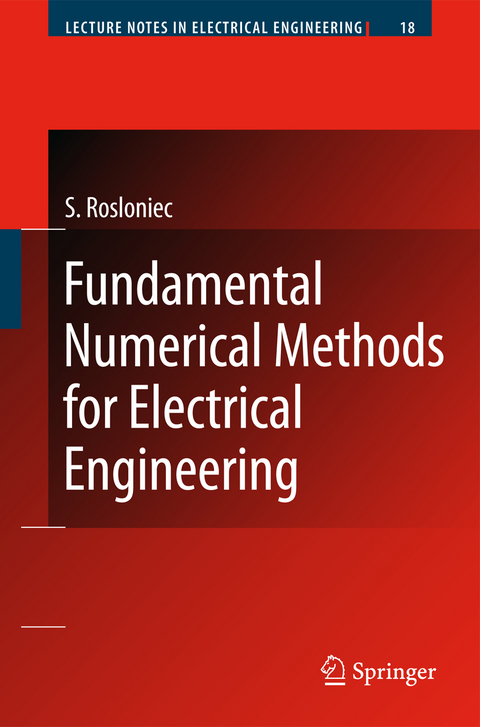
Fundamental Numerical Methods for Electrical Engineering
Seiten
2010
|
1. Softcover reprint of hardcover 1st ed. 2008
Springer Berlin (Verlag)
978-3-642-09844-4 (ISBN)
Springer Berlin (Verlag)
978-3-642-09844-4 (ISBN)
The book presents fundamental numerical methods which are most frequently applied in the electrical (electronic) engineering. Mathematical problems are solved step by step, and all methods discussed are illustrated with real-world examples of applications.
Stormy development of electronic computation techniques (computer systems and software), observed during the last decades, has made possible automation of data processing in many important human activity areas, such as science, technology, economics and labor organization. In a broadly understood technology area, this developmentledtoseparationofspecializedformsofusingcomputersforthedesign and manufacturing processes, that is: - computer-aided design (CAD) - computer-aided manufacture (CAM) In order to show the role of computer in the rst of the two applications m- tioned above, let us consider basic stages of the design process for a standard piece of electronic system, or equipment: - formulation of requirements concerning user properties (characteristics, para- ters) of the designed equipment, - elaboration of the initial, possibly general electric structure, - determination of mathematical model of the system on the basis of the adopted electric structure, - determination of basic responses (frequency- or time-domain) of the system, on the base of previously established mathematical model, - repeated modi cation of the adopted diagram (changing its structure or element values) in case, when it does not satisfy the adopted requirements, - preparation of design and technological documentation, - manufacturing of model (prototype) series, according to the prepared docum- tation, - testing the prototype under the aspect of its electric properties, mechanical du- bility and sensitivity to environment conditions, - modi cation of prototype documentation, if necessary, and handing over the documentation to series production. The most important stages of the process under discussion are illustrated in Fig. I. 1. xi xii Introduction Fig. I.
Stormy development of electronic computation techniques (computer systems and software), observed during the last decades, has made possible automation of data processing in many important human activity areas, such as science, technology, economics and labor organization. In a broadly understood technology area, this developmentledtoseparationofspecializedformsofusingcomputersforthedesign and manufacturing processes, that is: - computer-aided design (CAD) - computer-aided manufacture (CAM) In order to show the role of computer in the rst of the two applications m- tioned above, let us consider basic stages of the design process for a standard piece of electronic system, or equipment: - formulation of requirements concerning user properties (characteristics, para- ters) of the designed equipment, - elaboration of the initial, possibly general electric structure, - determination of mathematical model of the system on the basis of the adopted electric structure, - determination of basic responses (frequency- or time-domain) of the system, on the base of previously established mathematical model, - repeated modi cation of the adopted diagram (changing its structure or element values) in case, when it does not satisfy the adopted requirements, - preparation of design and technological documentation, - manufacturing of model (prototype) series, according to the prepared docum- tation, - testing the prototype under the aspect of its electric properties, mechanical du- bility and sensitivity to environment conditions, - modi cation of prototype documentation, if necessary, and handing over the documentation to series production. The most important stages of the process under discussion are illustrated in Fig. I. 1. xi xii Introduction Fig. I.
Methods for Numerical Solution of Linear Equations.- Methods for Numerical Solving the Single Nonlinear Equations.- Methods for Numerical Solution of Nonlinear Equations.- Methods for the Interpolation and Approximation of One Variable Function.- Methods for Numerical Integration of One and Two Variable Functions.- Numerical Differentiation of One and Two Variable Functions.- Methods for Numerical Integration of Ordinary Differential Equations.- The Finite Difference Method Adopted for Solving Laplace Boundary Value Problems.
| Erscheint lt. Verlag | 30.11.2010 |
|---|---|
| Reihe/Serie | Lecture Notes in Electrical Engineering |
| Zusatzinfo | XIV, 284 p. 301 illus. |
| Verlagsort | Berlin |
| Sprache | englisch |
| Maße | 155 x 235 mm |
| Gewicht | 456 g |
| Themenwelt | Technik ► Elektrotechnik / Energietechnik |
| Schlagworte | Automation • Computer • Computer-Aided Design (CAD) • Computer-Aided Manufacturing (CAM) • Development • differential equation • Electrical Engineering • Manufacturing • Model • Numerical Methods • ordinary differential equation • Production • Software • Standard |
| ISBN-10 | 3-642-09844-4 / 3642098444 |
| ISBN-13 | 978-3-642-09844-4 / 9783642098444 |
| Zustand | Neuware |
| Haben Sie eine Frage zum Produkt? |
Mehr entdecken
aus dem Bereich
aus dem Bereich
Kolbenmaschinen - Strömungsmaschinen - Kraftwerke
Buch | Hardcover (2023)
Hanser (Verlag)
49,99 €


